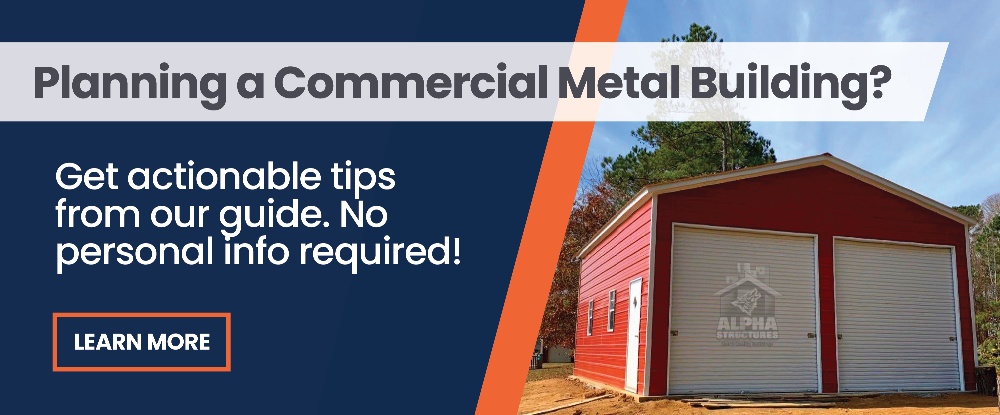How Much Does a Commercial Metal Building Cost?
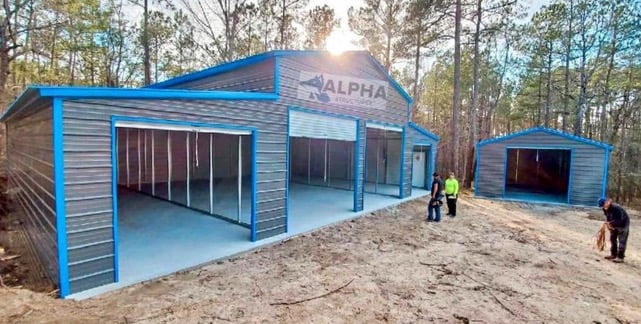
It’s no secret that all construction projects are a serious investment. Still, some buildings are less costly than others. If you’re looking into a commercial metal building, for example, you may already know they cost less than metal structures and hold up better over time.
But the true cost for your metal building can only be known once all the specifics are lined up.
The cost to erect a commercial metal building averages $10 to $25 per square foot. But this price can go as low as $6 a square foot (or as high as $120 per square foot), depending on current steel prices, your building’s size and design, the options available to you, and any customizations you pick.
Ebbing and flowing steel market prices, location, weather conditions in your locality, building complexity, and construction costs all affect the final price of your commercial metal building.
But overall, metal commercial buildings cost less than wood buildings, which average at $36 per square foot to build. Their construction takes months rather than weeks, and their lifetime maintenance costs are higher.
Size Matters with Commercial Metal Buildings
Commercial metal building prices range from $20,000 to more than $36,000. It all depends on building size, the number of windows and doors, the insulation used, and creature comforts like electricity, plumbing, and HVAC.
Popular commercial building sizes under $20,000 are 40x40 foot, 40x50 foot, and 40x60 foot. Larger buildings cost $36,000 or more. You can expect to pay around the following for buildings of these sizes:
- 40x60 foot building: $36,000
- 32x40 foot building: $20,000
- 50x100 foot building: $70,000-$80,000 on the East Coast and $80,000 to $90,000 on the West Coast
Your budget isn’t the only factor that affects building size. You must select a size that your land will support. You might want a 40x40-foot structure but learn your lot can only accommodate a 30x40 foot building. Make sure you know your lot dimensions and local requirements for placement to right-size your building.
Building height also affects cost. You might try to save money with a shorter building, but a structure that isn’t tall enough won’t work in commercial use, while a building that’s too tall lacks shade and costs more to heat and cool. A rigid-frame building provides ample usable space and headspace. Ceiling heights range from 20 to 40 feet, with most commercial buildings favoring the greater height.
Other Factors that Impact Commercial Metal Building Costs
So, how much will your commercial metal building cost? The answer is not simple. as many factors play into the final cost. For example, adding doors and windows and other customizations increases costs. Unique designs to address local engineering codes and loads, heavy snow loads, or high winds also boost the total cost. It’s therefore not possible to supply a consistent price list or catalog of prices.
Windows and Doors Cost for Commercial Metal Buildings
Windows and doors play an essential role in the look and function of a commercial metal building. Their shape, size, and location all call for consideration. When employees work inside, windows and doors must insulate them from heat, cold, and sound, all while offering fire protection and energy savings.
Hollow metal doors are the most affordable choice. Galvanized doors work as exterior doors and cost less than commercial steel doors, which offer superior endurance, security, and reliability. Heavy-duty, commercial-grade, metal roll-up doors for commercial buildings also add to the total price.
Windows increase building prices and can only be placed in certain locations. Standard windows are cost-effective for commercial metal buildings. Installers can put them anywhere. Metal-building-specific windows can only go on the sheathing. Single-hung, slim-line, and horizontal-side windows all work, as well. You can choose between insulated or non-insulated windows depending on the building application.
Insulating Your Metal Building
A variety of insulation options exist for commercial metal buildings. Some insulation solutions work better than others and some are more costly. The most popular insulation options are fiberglass insulation, spray foam, double bubble insulation, and prefabricated insulated panels.
- Double bubble insulation acts as bubble wrap for a metal building to control temperature and condensation and is a cost-effective solution for moisture control and minimal heating and cooling.
- Fiberglass insulation at 2 inches thick works well. Its R-8 value is lower than the R-32 value of insulation in most homes. Fiberglass insulation works best in applications with minimal heating and cooling.
- Spray foam closes gaps between the base, corner, eaves, and around all panel terminations to keep the building airtight. Most installers recommend some spray foam in corners and cracks to prevent heated or cooled air from escaping.
- Insulated metal panels also offer some benefits. Each panel comprises two single-skin metal panels and a foam core sealed at the sides. These prefabricated panels lock together to create building walls. But they are more expensive than traditional metal building panels.
Work with your installer to choose the right insulation for your building and budget, then have it professionally installed.
RELATED CONTENT: UPGRADES AND ADD-ONS FOR COMMERCIAL METAL BUILDINGS
Calculate Construction Costs
Erecting a metal commercial building takes far less time than a wood building. The times vary depending on size, the experience of the assembly crew, and the equipment at their disposal. Larger buildings need a lift to put trusses in place.
Expect shorter construction times for steel buildings, since manufacturers prefabricate the pieces. An installer can erect a small commercial building in a couple of days and a larger building within a week.
Though your commercial metal building supplier can estimate construction costs, prepping your site for installation remains unknown. Leveling the area and pouring the foundation adds cost. You can save money by placing concrete strips around the outside base of the building and using a dirt or gravel floor, but a more expensive concrete pad is best for commercial metal buildings.
In addition, if people will work inside the commercial metal building, you must also factor in the costs associated with HVAC, electrical, and plumbing installation.
The best approach to nailing down costs is selecting the right partner to walk you through this process and help you plan a commercial metal building that fits both your application and budget.
Comments
Recent posts
-
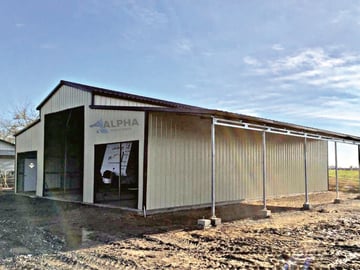
 4 REASONS WHY STEEL STORAGE BUILDINGS OUTPERFORM WOOD GARAGES
A metal garage is the greatest way to ensure that your automobiles and workplace...
December 11, 2022
4 REASONS WHY STEEL STORAGE BUILDINGS OUTPERFORM WOOD GARAGES
A metal garage is the greatest way to ensure that your automobiles and workplace...
December 11, 2022
-
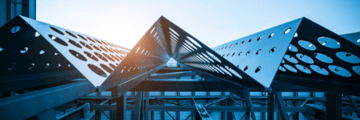
 Top 7 Uses for a Small, Attractive Commercial Metal Building
You know that old saying, "size doesn't matter?" Well, that rings true for comme...
December 11, 2022
Top 7 Uses for a Small, Attractive Commercial Metal Building
You know that old saying, "size doesn't matter?" Well, that rings true for comme...
December 11, 2022
-
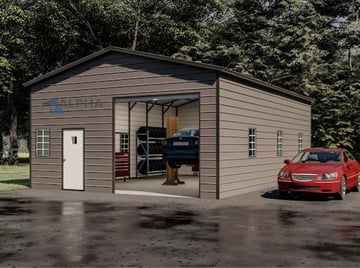
 Do Steel Storage Buildings Add Home Value: 7 FAQ Answered
Adding a garage to your property is one of the smartest investments you can make...
November 28, 2022
Do Steel Storage Buildings Add Home Value: 7 FAQ Answered
Adding a garage to your property is one of the smartest investments you can make...
November 28, 2022


